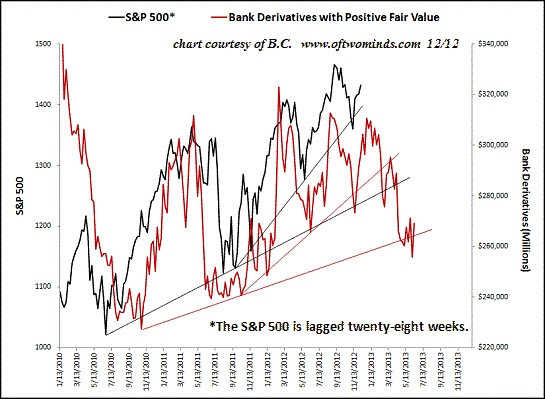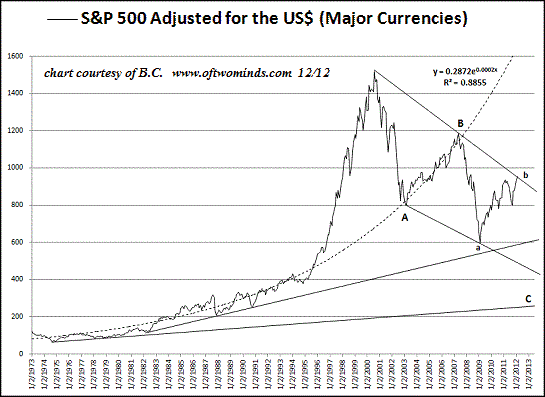

| Visitors Now: | |
| Total Visits: | |
| Total Stories: |

| Story Views | |
| Now: | |
| Last Hour: | |
| Last 24 Hours: | |
| Total: | |
The Two Charts You Should See Before Risking a Dime in the Market in 2013
Oftwominds.com‘s eclectic range of timely topics include finance, economy, stocks, housing, Asia, energy, long-term trends, social issues, urban planning, work/tradecraft, health/diet/fitness, sustainability, Les Paul guitars and The Great Transformation ahead: www.oftwominds.com/blog.html.
Two charts suggest a major decline is ahead in 2013.
“Don’t fight the Fed,” blah blah blah. Really? What did the market do after QE3 and QE4 were duly announced? It tanked.

Now that the Fed’s magic hat is visibly out of rabbits, there are all sorts of complexities we could hash over such as the effects of bank charge-off rates on GDP or the Theater of the Absurd “fiscal cliff” play-acting, but why waste all that time and energy when a number of charts forecast trouble for the stock market in 2013?

Charts courtesy of longtime correspondent B.C.
Hmm. If there is a correlation here, it doesn’t look positive for equities in 2013.Those familiar with McClellan’s chart know that it forecasts a serious decline in the SPX in early 2013, followed by a countertrend rally that tops in May. The decline after May is the Big One that punishes everyone who stayed long the SPX.

As a lagniappe, there is a third pattern suggesting a major decline just ahead:Three Peaks and A Domed House Pattern Signals An End To The Bull Market.
My new book Why Things Are Falling Apart and What We Can Do About It is now available in print and Kindle editions–10% to 20% discounts.
 1. Debt and financialization
1. Debt and financialization
2. Crony capitalism and the elimination of accountability
3. Diminishing returns
4. Centralization
5. Technological, financial and demographic changes in our economyComplex systems weakened by diminishing returns collapse under their own weight and are replaced by systems that are simpler, faster and affordable. If we cling to the old ways, our system will disintegrate. If we want sustainable prosperity rather than collapse, we must embrace a new model that is Decentralized, Adaptive, Transparent and Accountable (DATA).
We are not powerless. Not accepting responsibility and being powerless are two sides of the same coin: once we accept responsibility, we become powerful.
10% discount on the Kindle edition: $8.95(retail $9.95) print edition: $24 on Amazon.com
To receive a 20% discount on the print edition: $19.20 (retail $24), follow the link, open a Createspace account and enter discount code SJRGPLAB. (This is the only way I can offer a discount.)
| Thank you, Matthew N. ($5/month), for your superbly generous re-subscription to this site — I am greatly honored by your longstanding support and readership. | Thank you, James M. ($20), for your splendidly generous contribution to this site –I am greatly honored by your ongoing support and readership. |
for the full posts and archives.
2012-12-16 21:20:23
Source: http://charleshughsmith.blogspot.com/2012/12/the-two-charts-you-should-see-before.html
Source:


